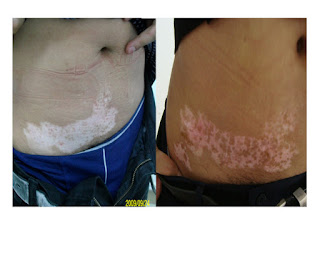Vitiligo condition that causes white patches all over the body has both
environmental and genetic causes. One possible theory is that vitiligo is an
autoimmune disease, a type of condition that causes the body's immune system to
mistakenly attack itself. Three genes have been discovered that may be
responsible for causing the immune system to attack and kill the
pigment-producing cells (melanocytes) in the skin.
Melanocytes produce melanin, the chemical that give skin its color. Without melanin, the skin is colorless.
But vitiligo may also be caused by a problem inside the melanocytes themselves, or it may have a neurological (nerve-related) component. That's because the white patches sometimes follow along the path of the nerves. Areas of the skin that are exposed to pressure such as bony elbows, knees, and ankles or to rubbing (mouth, eyes, and genitals) can turn white in vitiligo-prone people. Other traumatic events such as sunburn, physical trauma, and emotional stress can also trigger vitiligo.
There are two main types of vitiligo, a skin disease in which portions of the skin and hair lose their color and appear lighter than the surrounding areas.
Segmental vitiligo often begins when someone is young and only affects one part of the body, such as the face or one limb (and not the other). After growing for about a year, the condition usually stops spreading.
Non-segmental vitiligo, the most common type, affects both sides of the body and often begins on the hands or face. It tends to affect people over the course of their lives, covering larger and larger areas of skin.
Melanocytes produce melanin, the chemical that give skin its color. Without melanin, the skin is colorless.
But vitiligo may also be caused by a problem inside the melanocytes themselves, or it may have a neurological (nerve-related) component. That's because the white patches sometimes follow along the path of the nerves. Areas of the skin that are exposed to pressure such as bony elbows, knees, and ankles or to rubbing (mouth, eyes, and genitals) can turn white in vitiligo-prone people. Other traumatic events such as sunburn, physical trauma, and emotional stress can also trigger vitiligo.
There are two main types of vitiligo, a skin disease in which portions of the skin and hair lose their color and appear lighter than the surrounding areas.
Segmental vitiligo often begins when someone is young and only affects one part of the body, such as the face or one limb (and not the other). After growing for about a year, the condition usually stops spreading.
Non-segmental vitiligo, the most common type, affects both sides of the body and often begins on the hands or face. It tends to affect people over the course of their lives, covering larger and larger areas of skin.
